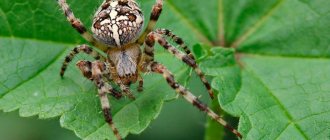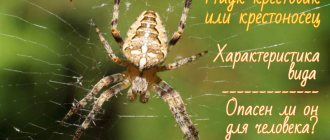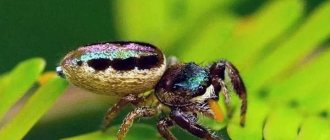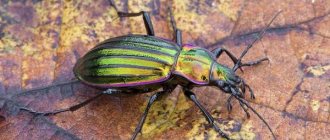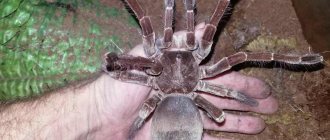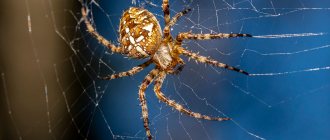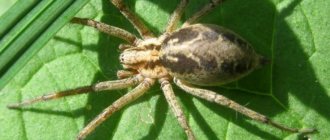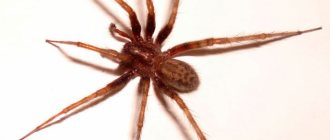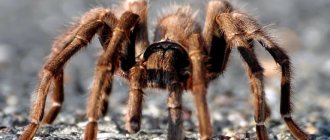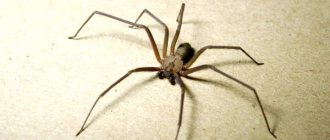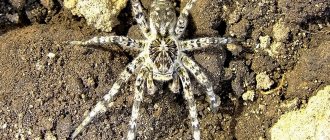Cross spiders are part of a large group of arachnids, numbering about 600 species, with about a dozen species found on our territory. This type of spider is found in all parts of our Planet, especially in places where moisture abounds. It is not problematic to meet these animals even in a human home.
These spiders got their name due to the presence of a peculiar cross-shaped pattern on their back. This pattern scares off many natural enemies, including humans.
General characteristics. External structure
The cross spider can be found in the forest, park, and on the window frames of village houses and cottages.
Most of the time, the spider sits in the center of its trapping network of adhesive thread - cobweb. The spider's body consists of two sections: a small elongated cephalothorax and a larger spherical abdomen. The abdomen is separated from the cephalothorax by a narrow constriction. Four pairs of walking legs are located on the sides of the cephalothorax. The body is covered with a light, durable and quite elastic chitinous cover.
The spider periodically moults, shedding its chitinous cover. At this time it is growing. At the anterior end of the cephalothorax there are four pairs of eyes, and below there is a pair of hook-shaped hard jaws - chelicerae. With them the spider grabs its prey.
There is a canal inside the chelicerae. Through the channel, poison from the poisonous glands located at their base enters the victim’s body. Next to the chelicerae there are short organs of touch, covered with sensitive hairs - the tentacles.
At the lower end of the abdomen there are three pairs of arachnoid warts that produce cobwebs - these are modified abdominal legs.
The liquid released from arachnoid warts instantly hardens in air and turns into a strong web thread. Different parts of arachnoid warts produce different types of webs. Spider threads vary in thickness, strength, and adhesiveness. The spider uses different types of web to build a trapping network: at its base there are stronger and non-sticky threads, and concentric threads are thinner and stickier. The spider uses webs to strengthen the walls of its shelters and to make cocoons for eggs.
Puberty and mating
Throughout the spring and summer, young males are mainly busy getting food for themselves and constantly weaving new webs. Such hunting guarantees them adequate nutrition. When the time comes for puberty, they leave their shelters and go in search of a female. While searching, they feed sparingly, which may explain the significant difference in weight category between males and females during the mating season.
Attracting a female is through mating games. To attract the attention of the female, the cross-tailed spider swings its web and dances at the same time. Mating involves the transfer of seminal fluid from the male's pedipalps to the female. After transferring the seed, the spider tries to hide as quickly as possible. But not many people succeed in this. Most of the crosses die from the poison of the female.
Internal structure
Digestive system
The spider's digestive system consists of the mouth, pharynx, esophagus, stomach, and intestines (front, middle and back). In the midgut, long blind processes increase its volume and absorption surface.
Undigested residues are expelled through the anus. The spider cannot eat solid food. Having caught prey (some insect) with the help of a web, he kills it with poison and lets digestive juices into his body. Under their influence, the contents of the captured insect liquefy, and the spider sucks it up. All that remains of the victim is an empty chitinous shell. This method of digestion is called extraintestinal.
Circulatory system
The spider's circulatory system is not closed. The heart looks like a long tube located on the dorsal side of the abdomen.
Blood vessels extend from the heart.
In a spider, the body cavity is of a mixed nature - during development it arises from the connection of the primary and secondary body cavities. Hemolymph circulates in the body.
Respiratory system
The spider's respiratory organs are the lungs and trachea. The lungs, or pulmonary sacs, are located below, in the front of the abdomen. These lungs developed from the gills of the distant ancestors of spiders that lived in water.
The cross spider has two pairs of non-branching tracheas - long tubes that deliver oxygen to organs and tissues. They are located in the back of the abdomen.
Nervous system
The spider's nervous system consists of the cephalothoracic nerve ganglion and numerous nerves extending from it.
Excretory system
The excretory system is represented by two long tubes - Malpighian vessels. One end of the Malpighian vessels ends blindly in the body of the spider, the other opens into the hind intestine. Harmful waste products come out through the walls of the Malpighian vessels, which are then excreted. Water is absorbed in the intestines. In this way, spiders conserve water so they can live in dry places.
Food and hunting
Spiders of this classification are predators. They lead a dual lifestyle. They usually hunt during the day and evening, and at night they repair nets and build new ones. Since this activity is unsafe during the day, spiders are waylaid by birds and other enemies. They actively obtain food for themselves depending on their habitat . Their diet mainly includes:
- flies;
- mosquitoes;
- butterflies;
- aphid.
In other regions, their diet is supplemented by midges, other insects, and sometimes even small animals. Surprisingly, not all insects can be included in the diet. If an uninvited guest with an unpleasant odor, an individual of impressive size, or a poisonous insect is caught in the web, the spider releases it, biting its webs.
During the hunt, the crossfish freezes in the very center of the web. From the outside it seems that the hunter is dead. When prey gets caught in the net, the crossfish reacts with lightning speed. The victim automatically becomes entangled in the net. At the same second, a hunter approaches her and plunges poisonous claws into her body. The prey is instantly paralyzed. The hunter can enjoy the delicacy here and now, or leave the prey in reserve.
The cross has a wonderful appetite. Every day he absorbs an amount of food approximately equal to his body weight. At one time he is able to eat more than 10 different insects. Therefore, he devotes most of his life to obtaining food. The crossman devotes little time to rest. After all, even when he is tired, the hunting signal thread tied to his leg will always notify him of the caught victim.
Arthropod lovers very often keep crosses as pets. Due to their behavioral characteristics and ease of care, spiders quickly reproduce in captivity. Most importantly, for this they need to be provided with a spacious terrarium. Since they weave webs of quite impressive size. It is worth noting that the bite of the cross spider is not dangerous for humans, so those who consider it poisonous can safely reconsider their point of view.
Reproduction. Development
Fertilization in spiders is internal. The female cross spider is larger than the male. The male transfers sperm to the female's genital opening using special outgrowths located on the front legs.
She lays eggs in a cocoon woven from a thin silky web. The cocoon weaves in various secluded places: under the bark of stumps, under stones. By winter, the female cross spider dies, and the eggs overwinter in a warm cocoon. In the spring, young spiders emerge from them. In the fall, they release cobwebs, and on them, like parachutes, they are carried by the wind over long distances - the spiders disperse.
general information
You can meet the common cross spider in almost every country. They live on all continents except northern and southern latitudes. In total, there are more than 40 thousand different species of arachnids in the world, 2 thousand of which are crosses. The territory of Russia can boast of only 10 species of these arthropods. They belong to the family of orb-weavers, a genus of araneomorphic spiders. They are most common in the areas:
- Rostov;
- Smolenskaya;
- Astrakhan.
Arthropods are very often found in the Mordovian region.
The size of cross spiders is quite small. But it is worth noting that the female of this species is larger in size. The length of the male is only up to 1.1 cm. His partner can reach 4 cm. The female and male sexes can be distinguished from each other by their abdomen. In males it is small and narrow, in females it is round and large. The external structure of the cross spider does not differ significantly from its relatives in its genus. At first glance, this is a completely ordinary spider, except for the peculiarities of its external color.
Precautionary measures
Even if the bite is not fatal, it can cause a lot of trouble.
To avoid this you need to follow some rules:
- When spending the night in nature, you have to sleep in a tent, so before spending the night, check the fabric room for an invasion of “eight-legged guests.”
- Before putting on clothes and shoes, check for spiders inside. The same applies to bedding.
- If you find a web, it is better not to contact it, since only “evil” female crosses weave webs.
- If there is a spider in front of you, you should not run away; it is better not to do anything at all and protect small children from it.
Interesting Facts
A spider with a cross has the following features:
- The web of the cross is of great interest. It is elastic and has high strength. Since ancient times it has been used to make fabrics or decorations. People from tropical countries weave nets and nets from it to catch fish.
- Microbiologists have also not ignored the spider web. They use it to determine the composition of atmospheric air, as well as to produce the thinnest optical fiber.
- Interestingly, spiders move freely through their trapping webs and do not stick to them. This is explained by the fact that they move along radial, dry threads.
Crossmen are unique creatures. They can be very useful for a person. But if, due to an unfortunate combination of circumstances, the arthropod still bites, then first aid measures should be taken. But there is no reason to seriously fear for your health after this.
Is it dangerous to humans?
The cross is absolutely harmless to people. There are stories that the spider is poisonous and that after being bitten a person can die. This is wrong. Yes, he can bite and the bite will be painful. There are rules that will help you get rid of pain. You need to know that the crossman never attacks first. It can bite if a person gets caught in its net with their hand. Not on purpose, but for the spider this is a signal of a threat to its life. He defends himself as best he can.
Rice. 5. Spider Araneus diadematus When bitten, after 5 minutes the following sensations occur:
- your head starts to hurt;
- weakness appears in the body;
- there is aching in the joints;
- the bite site is very itchy;
- Subcutaneous hemorrhages may appear on the body.
It is recommended to wash the bite area with soap and water. Then apply something cold. Ideally, ice. For headaches and fever, it is best to take paracetamol. If you have allergies, you need to take antihistamines.
Important! If a child is bitten by a spider, urgent medical attention is needed!
It is known that the bites of some species of crosses are more painful than the bites of scorpions.
Natural habitats
Crusader spiders live throughout the Eurasian continent, including North America. These spiders love high humidity, high temperature and lack of sunlight. Spiders are found mainly in forests, on the edges of forests, in meadows, fields, gardens, etc. On our territory there are up to 30 species of crusader spiders.
Important point! In a human home, this spider weaves a web in places where there is little light and no noise. These can be far corners, both at the top and bottom of the room, as well as behind furniture. Its diet includes flies, cockroaches and other harmful insects. To get rid of such an unpleasant neighborhood, you can remove the web and throw it along with the spider outside, although the spider does not pose a danger to humans.
Budova pavuka-khrestovika
The cross spider is the most common creature of our forests. This spider, which is yellowish-brown or even blackened with bark, can be easily recognized by the white cross-like flame on the dorsal side of the body. These peculiarities of this type are called chrestovika. His zabarvlennya may be of the greatest significance; there is no way to stop him in the dark in the middle of the thick tea leaves, between the bushes of the trees.
With these signs of the future, the cross spider predicts the crayfish, and at the same time reveals a number of features associated with a different way of life. The class of spider-like creatures changed during the gradual transition from an aquatic to a terrestrial way of life. Like the crayfish, the body of the spider-like class (the spider spider) consists of two sections: the cephalothorax and the petiole. The ale stalk is very swollen and undifferentiated. In contrast to crustaceans, there are no whiskers on the head of the spider spider. The spider spider, like the tick, has no folding eyes. On the upper side of the head there are very simple glasses, and on the lower side, near the mouth, two pairs of slits. Spiders are tiny creatures. The stinks are grubby the mosquitoes. With the front pair of slits, the spider drives the bean. At the base of the cracks there are ruined vines. When the claws that end the cracks crash into the wound, the cuttings flow into the wound and kill the victim.
With another pair of slits, the spider grazes the zdobich. Behind the cracks there are rotted pairs of long walking legs. Like crayfish, the spider's legs are folded into round joints. The skin of the leg ends in jagged claws, so the spider can run on its net without getting lost in it. Claws also help spiders weave cobwebs. When replacing crayfish with brooches, there are no endings.
Pavuk khrestovik
The spider spider is classified as an arthropod, a representative of the spider-like class. Pavuk-khrestovik his zdobich to catch for additional pavutini. The spinning apparatus of spiders is made up of external structures - spider warts - and internal organs - spider veins. Three pairs of spider web warts grow on the back end of the petiole. This skin wart is pierced at the end with a hundred different openings. From the skin opening a speck of sticky thread is woven, like a spider weaving into the thinnest thread in Russia. These threads become angry and thicken in the wind. The result is a thin, scarlet thread. This kind of glue can be seen in numerous cobwebs growing in the back of the stalk. Ducts open on their spider warts.
Black widow, false black widow
It is the most poisonous creature on earth. Black widows belong to the karakurt family.
The false black widow is slightly different in appearance and its venom is not as strong. Provokes allergies.
The appearance is memorable - long black legs, cephalothorax, abdomen with a glossy sheen. On the lower part there is a characteristic red hourglass pattern; in false black widows it is pink, white and brown.
Poisonous spiders also include wolves, cross spiders, and hermits. They bite hard, but not fatally. In most cases, the consequences are limited to an allergic reaction.
Types of cross spider
The number of species of such spiders is impressive, but of the arachnids known to science, about 620 species have been described in the genus of spiders. Their representatives live all over the world, but they still prefer to settle in temperate and tropical zones, because they cannot tolerate too cold a climate.
Let's present some varieties in more detail.
1. Ordinary cross. This type is considered the most common. Similar living creatures live among bushes, meadows, fields and coniferous forests of the European and northern American continents.
They prefer damp areas and take root well in swampy areas, near rivers and other bodies of water. Their body is reliably protected by a durable thick shell, and humidity preserves a special waxy coating on it.
This cross spider is decorated with a white pattern on a general brown background. Such a complex pattern, upon close examination, may seem very interesting.
2. Angular cross is a rare variety, and in the Baltic regions it is generally considered endangered. It is interesting that such arthropods, although they belong to the genus Crusader, do not have a characteristic sign on their body.
And instead of this feature, on the belly of the creatures, covered with light hairs, two small humps stand out.
3. The barn spider is a native of North America. The trapping nets of these creatures, which are sometimes of considerable size, can be found in abandoned mines, grottoes and rocks, as well as near human habitation.
These creatures are dark brown in color. Thanks to such colors, they are camouflaged against the background of their surroundings. The legs of such spiders are striped and covered with white hairs.
In America there is a species of cross - guinea
4. The cat-faced spider is another inhabitant of regions of America similar to the previously described species. Its body is also covered with fluff, and the hairs can be either light or dark. These are very small creatures. Some specimens may be less than 6 mm.
But if this is a large cross spider of this type, then it is probably a female, because their size can reach up to 2.5 cm. These arachnids got their name for a very interesting pattern on the abdomen, vaguely reminiscent of a cat’s face.
This decoration for these creatures is located in the place where their relatives usually have a cross.
The cat-faced spider has a shape similar to the face of a cat on its body
5. Pringles spider is a small-sized resident of Asia, also common in Australia. This cross spider : black abdomen is marked with a funny white pattern, while the cephalothorax and legs of such spiders are green to match the color of the rich vegetation of the regions where such creatures live. The size of males in some cases is so small that they do not exceed 3 mm.
Barn spider
This is a North American species of araneomorph spider. It lives in the eastern United States and bordering Canada.
In a southern direction, it is distributed all the way to Kansas. The barn spider is nocturnal. During the day it hides in rolled up leaves, and at night it comes out to hunt in the center of the web.
Female - 13-22 mm, male - 10-20 mm.
Barns, caves, and mine entrances are his favorite places to live.
It can often be found in rural areas, where there are many flying insects that are attracted to light.
Late summer-autumn is the most active period in the life of an insect.
Cross spider Araneus albotriangulus
0 The cross spider Araneus albotriangulus lives in Australia (New South Wales and Queensland). The crosswort has very small body sizes: females grow up to 4 mm, the length of males does not exceed 2 mm. Instead of the traditional cross, yellow or light brown spots are symmetrically located on the abdomen, resembling wings or right triangles.
Meadow cross (four-spotted)
It is the most common cross in Russia.
Color varies from light yellow to dark brown. A special feature is 4 light spots or 4 dark spots (this depends on the color of the main background of the body).
Quite large - the length of individuals reaches 20 mm. It takes root well in insectariums - its lifespan there is from 200 days.
Chilly cross
Its color is always yellow-orange, with beige splashes. The abdomen is decorated with white spots.
It always weaves a web near the ground, hiding in nearby leaves, having previously entwined them.
Wet forests, swamps, and deciduous shrubs are its favorite habitats.
Not as popular as previous types, in some countries it is practically non-existent.
Dimensions: male - 5-6 cm, female - 7-13 cm.
Oak cross
Lives in temperate latitudes, weaving webs in the tall grass of forest edges, in bushes or thickets.
Russia, Europe, North Africa, the Asian region north of the Himalayas (except for the Arabian Peninsula) are all habitats of the arthropod.
A special feature of this insect is its shaggy cephalothorax and body, pointed on both sides.
Dimensions.
Male - 7-8 mm, female - 12-14 mm.
What are the benefits of the crusader spider?
Firstly, we dispelled the myth that the cross spider is poisonous to humans. Secondly, it must be proven that it brings considerable benefits in nature. An adult crosswort, of any type, destroys a large number of insect pests that are carriers of dangerous diseases.
- Strong threads of spider web have been used since ancient times for weaving fishing gear: nets and nets.
- The web is the basis of many fabrics and decorations. For example, the French wove stockings and gloves from threads of spider webs.
- Even scientific research uses spider webs. It is used in microbiology to determine the composition of atmospheric air.
- Some scientists have long been using spider webs in optical measuring instruments.
- It is believed that the spider's web has disinfecting and antiseptic properties, as it is capable of destroying bacteria and viruses.
Therefore, if you meet a spider with a cross on the outside of its abdomen on your way, you should not run away “like fire”; remember that it is not dangerous, but very useful.
Sources
- https://faunistics.com/pauk-krestovik/
- https://dezplan.ru/vopros/pauk-krestonosec
- https://premier-agro.ru/pauk-krestovik-opisanie-stroenie-gde-obitaet-pitanie/
- https://wildfauna.ru/pauk-krestovik
- https://givnost.ru/krestovik-pauk-opisanie-osobennosti-vidy-obraz-zhizni-i-sreda-obitaniya-krestovika/
- https://obnaruzhil.ru/pauk/pauk-krestovik.html
- https://fishki.net/2171165-pro-pauka-krestovika.html
- https://TaraKlop.ru/pauki/pauk-krestovik/
- https://domvred.ru/pauk-krestovik/
- https://dezbox.ru/dezinsekciya/opasen-li-pauk-krestovik-dlya-cheloveka/
[collapse]
Arachnids
This net has over 100,000 of these little dots. Mosquitoes stick to them with their wings and paws and swoop down on the edge. The spider itself either hangs head down in the center of the spider web, or hangs to the side under the leaf. In this case, a signal thread is stretched to itself from the center of the web.
When a housefly gets caught in the middle, the spider, having sensed the three-ton signal thread, rushes out of its hiding spot. With open claws, the spider kills the victim and sees herbal juices in its body. After which he wraps a fly or another mosquito with cobwebs and deprives it for an hour.
Under the influx of herbal juices, the internal organs of the spider's victim are quickly poisoned. After about an hour, the spider turns to the victim and extracts all the living words from it. As mosquitoes in the web lose only their empty chitinous covering.
A prepared trap is a series of unrelated actions interconnected. The passion for such actions is instinctive and is transmitted spasmodically. It’s easy to overcrowd, following the behavior of young spiders. If the smell comes out of the eggs, no one will recognize them as working as a catcher, but the spiders will immediately smell the spider.
